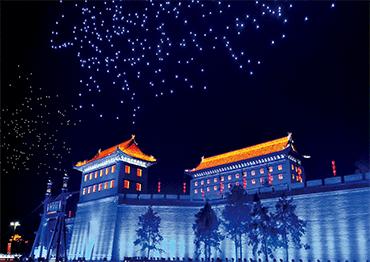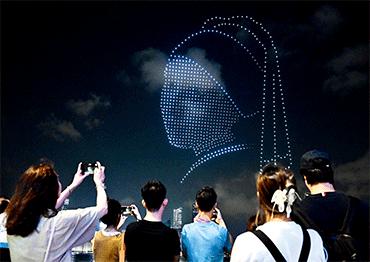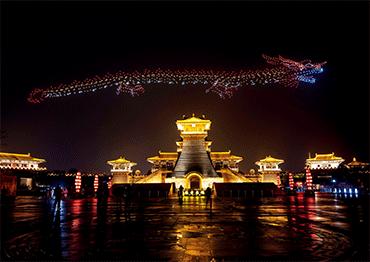Chinese companies are latecomers to the drone performance market. The world’s ffrst outdoor drone performance was at an electronic arts festival in the northern Austrian city of Linz in 2012, which attracted 90,000 spectators.
The 2017 Super Bowl half-time show in Houston, Texas pushed drone performances into the mainstream, when hundreds of Intel’s Shooting Star drones formed a glittering backdrop for singer Lady Gaga. Then in 2018, a drone performance made a global sensation when Intel used 1,218 illuminated drones to create the Olympic rings and other images during the opening ceremony of the Pyeongchang Winter Olympics in South Korea on February 9, 2018.
China’s first outdoor drone performance was in 2016 at an event hosted by the State-run China Central Television (CCTV). Although quite a few drone startups had emerged by that time, they were all focused on the consumer market to become the next DJI, the Shenzhen-based drone company that accounts for a significant proportion of global consumer drone sales. They did not appreciate at first how lucrative the drone show business would become.
“CCTV approached almost all the drone companies in Shenzhen, and Damoda was the first to dare take a chance with the booking,” said Qin Haiqun, vice general manager of Damoda, a Shenzhen-based drone manufacture and one of the market leaders in China.
Qin said that Damoda was established in 2015 and had only developed a drone control system and a prototype drone model. Its products were not yet for general sale. But the air show involving 80 drones was an immediate hit, and Damoda was soon flooded with drone show bookings.
Many other drone startups soon joined the fray. According to the Shenzhen UAV Industry Association, China’s drone show market is currently dominated by four major companies, Damoda, HighGreat, Efy Technology and EHang, which have a combined domestic market share of 90 percent.
At a drone show in May 2021, Shenzhen HighGreat set four Guinness World Records: the highest number of drones flying simultaneously with 5,164, the largest light image composed by 5,184 drones, the longest animation show performed by drones (26 minutes and 26 seconds), and the most different consecutive formations by a single fleet at 88 maneuvers.
“From a technical perspective, controlling tens of thousands of drones for a performance is not a problem at all, though it exceeds current market demand,” Li Chenliang, chief innovation officer of HighGreat, a Shenzhen-based drone manufacturer, told NewsChina. “Setting records for the sake of it has become less and less meaningful.”
But China has emerged as a global drone show market leader. “Overseas companies pioneered drone performances, but they didn’t swiftly develop it into a separate niche market,” Li said. Intel, for example, primarily utilized drone performances to promote its corporate image and technological capabilities rather than expanding into the drone show market.
By comparison, since making their maiden flights in China in 2016, drone shows quickly developed into a significant market. According to a 2022 report released by the Tourism Data Innovation Alliance (TDIA), a tourism data provider, 7,228 outdoor drone shows were presented in 2021 throughout China.
Another report released by market research publisher QYResearch in August 2022 showed that the value of the drone show market in China reached US$104 million in 2021, accounting for 60.8 percent of the global market, which was valued at US$170 million. The report estimated that the global market will expand to US$719 million in 2029, with the Chinese market projected to account for 65 percent of the global total.
“Chinese companies lead in both the quality of drone performances and market share,” Yang Jincai, chairman of the World UAV Conference and founding president of the Shenzhen UAV Industry Association, told NewsChina, “Chinese companies are now highly sought after by organizers of overseas festivals and exhibitions given their technological capability and competitive pricing.”

 Old Version
Old Version


